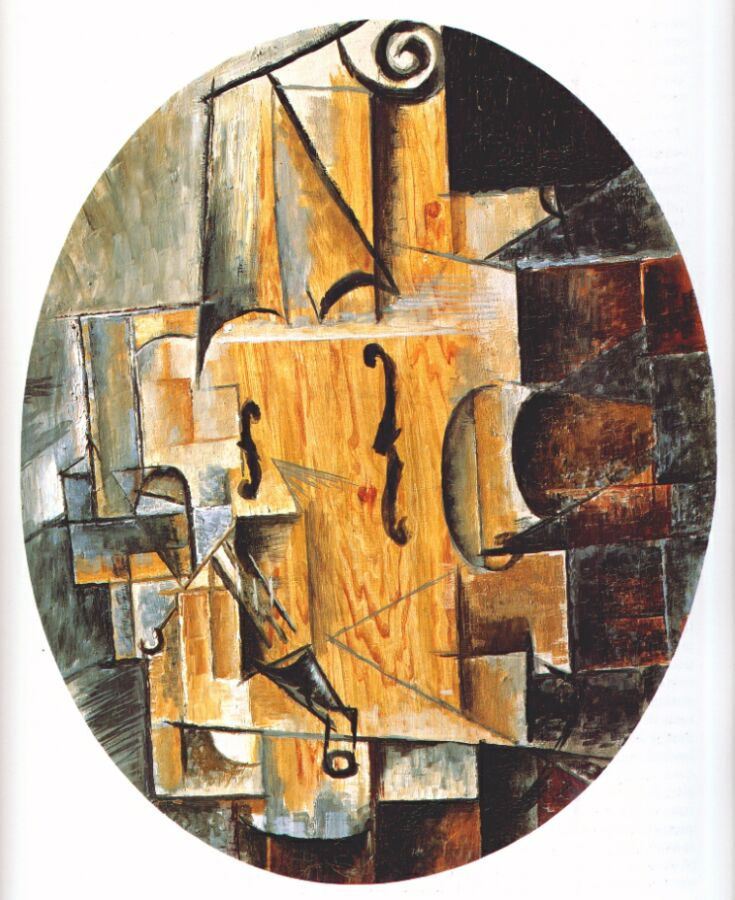log in
Enter site
Login to use Arthive functionality to the maximum
Violin
Pablo Picasso • Painting, 1912, 55×46 cm
Description of the artwork «Violin»
In 1912, Pablo Picasso experienced another change of style. Although it would be more accurate to say, a serious change in the same style. Over the past two years, Picasso accompanied by Georges Braque completely devoted himself to the analytical Cubism, which influenced the development of the entire world of art of the 20th century. In the spring of 1912, Picasso went on a journey from which he brought a picture called Memory of Le Havre. It was still Cubism, but a completely new Cubism, the one that would later be called synthetic. The Violin painting is one of the first works in this updated style.
Georges Braque immediately picked up the change of mood of his friend and companion, and they began to explore new opportunities with enthusiasm. Gradually their works began to have recognizable details. At the beginning of this period, Picasso created several series of paintings, united by one theme: musical instruments (violins and guitars), still lifes with bottles and glasses. At the end of the period of synthetic cubism, the artist primarily concentrated on portraits (of course, we remember the Harlequin).
The first Picasso’s Violin is still completely picturesque. Having analyzed the objects and faces of people on disparate details during the period of analytical Cubism, the artist seemed to start composing this mosaic together, turning it into a sort of a picturesque collage. Soon, however, collages would become quite real. Without stopping for a second in his experiments, Picasso and Braque began to supplement their work with unusual materials. In the same year of 1912, Picasso used a real postage stamp in his picture for the first time, and then created the Still Life with a Chair Caning, in which he applied oilcloth and twine. The subsequent works by the artist would contain newspaper clippings, pieces of cloth, wallpapers and music sheets. Justifying the name of the synthetic Cubism to the full extent, Picasso accumulated a variety of techniques and finished objects, and has actually laid the foundation for the appearance of ready-mades in the future.
Georges Braque immediately picked up the change of mood of his friend and companion, and they began to explore new opportunities with enthusiasm. Gradually their works began to have recognizable details. At the beginning of this period, Picasso created several series of paintings, united by one theme: musical instruments (violins and guitars), still lifes with bottles and glasses. At the end of the period of synthetic cubism, the artist primarily concentrated on portraits (of course, we remember the Harlequin).
The first Picasso’s Violin is still completely picturesque. Having analyzed the objects and faces of people on disparate details during the period of analytical Cubism, the artist seemed to start composing this mosaic together, turning it into a sort of a picturesque collage. Soon, however, collages would become quite real. Without stopping for a second in his experiments, Picasso and Braque began to supplement their work with unusual materials. In the same year of 1912, Picasso used a real postage stamp in his picture for the first time, and then created the Still Life with a Chair Caning, in which he applied oilcloth and twine. The subsequent works by the artist would contain newspaper clippings, pieces of cloth, wallpapers and music sheets. Justifying the name of the synthetic Cubism to the full extent, Picasso accumulated a variety of techniques and finished objects, and has actually laid the foundation for the appearance of ready-mades in the future.


